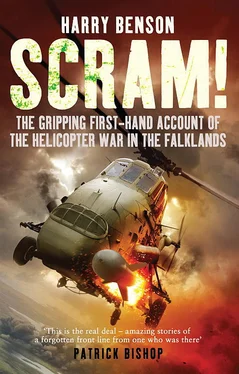Pollock realised that he was going to have to work hard to keep his pilots and aircrew alive. The training on the way south had shown that crews could cope with long periods of flying at extremely low level over the sea using the night vision goggles. But the extra hour, and often much longer, of flying and navigating over the featureless terrain of the Falklands was going to increase the workload in the cockpit dramatically. Keeping crews rested and aircraft serviced meant his four night-flying Sea Kings would not be available for flying during the day. Dealing with the many frustrations this posed meant keeping good relations with Admiral Sandy Woodward’s staff who were running the campaign, the captain’s staff who were running the ship, and the aviation staff who were running aircraft operations.
Planning was also complicated, split between the 3 Brigade command on board Fearless , still parked off the coast of Ascension Island, and the planning team on board Hermes , some 4,000 miles south. Wardroom Two on Hermes was closed off for special forces planning. None of the aircrew or troops actually involved in the missions was allowed inside so as not to compromise other missions if they were captured and interrogated. But coordination was needed to make sure each individual mission was achievable and that aircraft wouldn’t suddenly run into one another in the dark.
Somebody also needed to make sure the returning helicopters weren’t going to get shot down by their own side. Low-flying aircraft unexpectedly approaching the fleet at night from the direction of the Falklands were likely to have a brief and unpleasant encounter with a Sea Harrier or a Sea Dart missile. The fleet needed to know when the Sea Kings were going out and when they were coming in. Somebody had to negotiate this complex chain of command and make sure everybody knew what they needed to know. Only Lieutenant Commander Bill Pollock knew all the details. It meant he wasn’t going to get much flying done himself.
On the evening of Friday 30 April, the British carrier group entered the 200-mile Total Exclusion Zone (TEZ) now declared around the islands. Any non-British ship or aircraft entering this zone could expect to be fired upon without warning. The Falklands War kicked off for real approaching midnight as Lieutenant Nigel North’s flight of three junglie Sea Kings lifted off from the deck of Hermes .
North had started his preparation four hours before launch time with a briefing of all the crews, followed by the individual brief for his particular mission. It was a pleasant night as he walked out across the flight deck of the carrier. The dark shapes of the three Sea Kings with their drooping blades awaited their occupants. As mission leader, his first job was to lead the formation of Sea Kings across the eighty miles of South Atlantic now separating Hermes from Concordia Rock.
As the crews prepared each of the Sea Kings for startup, heavily laden SAS and SBS troops boarded the aircraft with their huge bergens. With rotors turning and a final fix of their position from the ship, the formation lifted off and disappeared into the blackness. The Sea Kings flew low across the sea. Without goggles, the world outside was black and unmoving. With them, a green sea scrolled beneath the aircraft as the pilots headed towards a green horizon. After a couple of position checks from the other aircraft, North was satisfied that he was to coast in on track at the right place.
The sea transit in formation went well. Even so, North felt mighty relieved to hit landfall within a mile of Concordia Rock. The navigation system was working. The formation then split to go their separate ways and North now concentrated on his own individual mission. Apart from flights around Salisbury Plain and Ascension Island, this was the first time any of the crews had flown at low level over land at night. Throughout the journey south, all of the crews had spent hours poring over maps of the Falklands to try to memorise the main features and get a mental picture of what was to come. What North and his co-pilot Lieutenant Alan ‘Wiggy’ Bennett had not expected was that the ground seemed to be covered in snow. Cursing the ‘met’ man on Hermes for failing to forecast accurately, they continued on.
The drop-off point for the SAS team was just north-west of Estancia House, a collection of farm buildings some twelve miles from the capital Port Stanley. Depositing their troops on the ground with surprising ease, the crew were convinced the roar of the helicopter would be heard throughout the entire Falklands. But shielded from the capital by a line of hills, it was doubtful whether anyone would have heard them. After lifting off, aircrewman Colin Tattersall leant forward to say he had cut a piece of Falklands heather for the pilots to take back to the ship, but he had seen no sign of snow. It was just how the grassland looked through the goggles. The met man was reprieved.
Still feeling nervous about the noise they were making the pilots focused on getting back to the sea and relative safety as quickly as possible. In the back, Tattersall was pointing a radar-warning receiver in all directions. There were no emissions. The Argentines didn’t even know they were there.
Having set off in formation, the three aircraft dropped their teams and returned to Hermes individually. Bob Horton and Paul Humphreys in one of the other Sea Kings had seen another aircraft, most likely Argentine, but evaded successfully. The first covert mission of the war had been a remarkable success.
Later on board Hermes , Bill Pollock went to debrief Captain Lyn Middleton, and presented him with some heather: ‘A piece of the Falkland Islands for you, sir.’
‘Bloody hell,’ replied Middleton. ‘If we’re going to take the Falklands bit by bit, it’s going to take a long time.’
* * *
Just before dawn on 1 May, an RAF Vulcan bomber from Ascension Island, 4,000 miles to the north, conducted an extreme long-range bombing raid on Port Stanley airfield. This mission was the first of seven codenamed ‘Black Buck’. As an exercise in logistics it was genuinely impressive and remarkable. Eleven Victor tankers and two Vulcans took off from Wideawake airfield at midnight in order that one Vulcan could drop its load of twenty-one 1,000-pound bombs diagonally across the runway.
The effectiveness of the mission itself was rather more questionable. Only one of the bombs hit the runway, with negligible effect on Argentine operations. Subsequent bombing missions missed the runway altogether. Even if they had hit, the crew forgot to arm the bombs on their second mission, according to the commanding officer of 801 Sea Harrier squadron. It was an unbelievable error after all the effort to get them there. Later missions launched Shrike missile strikes against radar installations. For this, the radars had to be switched on in order to allow the missile to home in. Realising the threat, the Argentine operators simply switched their radars off. The missions achieved little.
The RAF publicity machine subsequently tried to talk up how the Black Buck raids demonstrated their ability to bomb the Argentine mainland. However, a single unescorted Vulcan bomber would have been easy meat for an Argentine Mirage fighter. It was an empty threat. The credit claimed for the Vulcan raids demeaned the actual RAF contribution of pilots, engineers and aircraft, which, even if relatively small, was both important and significant. This was neither. The entire Black Buck mission turned out to be an expensive and ineffective exercise in inter-service politics.
What Black Buck One undoubtedly achieved was to wake up the Argentine defences in time for the surprise dawn raid on Port Stanley airfield by the Sea Harriers of 800 Squadron. Launched from Hermes a hundred miles north-east of Stanley, nine Sea Harriers attacked the airfield at low level. Two toss bombs hit the runway scarring it; others bombs left the airfield facilities in smoke and flames. The other three jets attacked the grass airstrip at Goose Green, to where all of the twelve Argentine Pucara twin turboprop attack aircraft had been moved. One Pucara was destroyed in the attack by a direct hit and two others were damaged.
Читать дальше












